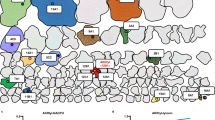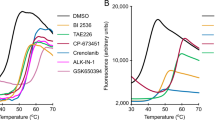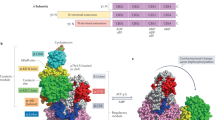Abstract
arising from B. Xiao et al. Nature 472, 230–233 (2011)10.1038/nature09932
The AMP-activated protein kinase (AMPK), an αβγ heterotrimeric enzyme, has a central role in regulating cellular metabolism and energy homeostasis1. The α-subunit of AMPK possesses the catalytic kinase domain, followed by a regulatory region comprising the autoinhibitory domain (AID) and α-linker2,3. Structural and biochemical studies suggested that AID is central to mammalian AMPK regulation4; however, this notion has been challenged recently by Xiao et al. on the basis of their active AMPK structure (Protein Data Bank accession 2Y94)5. On close inspection, however, we found that the α-subunit regulatory region was incorrectly built in their model, and our rebuilt model suggests a universal occurrence of the AID domain in AMPKs; we have also identified a novel regulatory motif that is essential for AMPK regulation.
This is a preview of subscription content, access via your institution
Access options
Subscribe to this journal
Receive 51 print issues and online access
$199.00 per year
only $3.90 per issue
Buy this article
- Purchase on Springer Link
- Instant access to full article PDF
Prices may be subject to local taxes which are calculated during checkout


Similar content being viewed by others
References
Hardie, D. G., Ross, F. A. & Hawley, S. A. AMPK: a nutrient and energy sensor that maintains energy homeostasis. Nature Rev. Mol. Cell Biol. 13, 251–262 (2012)
Crute, B. E., Seefeld, K., Gamble, J., Kemp, B. E. & Witters, L. A. Functional domains of the α1 catalytic subunit of the AMP-activated protein kinase. J. Biol. Chem. 273, 35347–35354 (1998)
Pang, T. et al. Conserved α-helix acts as autoinhibitory sequence in AMP-activated protein kinase α subunits. J. Biol. Chem. 282, 495–506 (2007)
Chen, L. et al. Structural insight into the autoinhibition mechanism of AMP-activated protein kinase. Nature 459, 1146–1149 (2009)
Xiao, B. et al. Structure of mammalian AMPK and its regulation by ADP. Nature 472, 230–233 (2011)
Hardie, D. G., Carling, D. & Gamblin, S. J. AMP-activated protein kinase: also regulated by ADP? Trends Biochem. Sci. 36, 470–477 (2011)
Oakhill, J. S., Scott, J. W. & Kemp, B. E. AMPK functions as an adenylate charge-regulated protein kinase. Trends Endocrinol. Metab. 23, 125–132 (2012)
Chen, L. et al. AMP-activated protein kinase undergoes nucleotide-dependent conformational changes. Nature Struct. Mol. Biol. 19, 716–718 (2012)
Townley, R. & Shapiro, L. Crystal structures of the adenylate sensor from fission yeast AMP-activated protein kinase. Science 315, 1726–1729 (2007)
Amodeo, G. A., Rudolph, M. J. & Tong, L. Crystal structure of the heterotrimer core of Saccharomyces cerevisiae AMPK homologue SNF1. Nature 449, 492–495 (2007)
Xiao, B. et al. Structural basis for AMP binding to mammalian AMP-activated protein kinase. Nature 449, 496–500 (2007)
Jin, X., Townley, R. & Shapiro, L. Structural insight into AMPK regulation: ADP comes into play. Structure 15, 1285–1295 (2007)
Oakhill, J. S. et al. β-Subunit myristoylation is the gatekeeper for initiating metabolic stress sensing by AMP-activated protein kinase (AMPK). Proc. Natl Acad. Sci. USA 107, 19237–19241 (2010)
Neumann, D., Woods, A., Carling, D., Wallimann, T. & Schlattner, U. Mammalian AMP-activated protein kinase: functional, heterotrimeric complexes by co-expression of subunits in Escherichia coli. Protein Expr. Purif. 30, 230–237 (2003)
Author information
Authors and Affiliations
Contributions
L.C., F.-J.X., J.W., Y.-Y.Z., L.-S.C. and C.L. performed the X-ray structural and mutational studies; J.H. and S.W. carried out NMR studies; Z.-X.W., U.S., D.N., B.X., S.F.Y. and P.L. contributed to discussions and manuscript writing; J.-W.W. led the team and wrote the paper. Coordinates have been deposited into the Protein Data Bank with accession codes 4F2L for the rat α1-AID crystal structure and 2LTU for the human α2-AID NMR solution structure, respectively.
Corresponding author
Ethics declarations
Competing interests
Competing Financial Interests Declared none.
PowerPoint slides
Rights and permissions
About this article
Cite this article
Chen, L., Xin, FJ., Wang, J. et al. Conserved regulatory elements in AMPK. Nature 498, E8–E10 (2013). https://doi.org/10.1038/nature12189
Received:
Accepted:
Published:
Issue Date:
DOI: https://doi.org/10.1038/nature12189
This article is cited by
-
Synthetic energy sensor AMPfret deciphers adenylate-dependent AMPK activation mechanism
Nature Communications (2019)
-
AMP-activated protein kinase: the current landscape for drug development
Nature Reviews Drug Discovery (2019)
-
Transcriptional and post-translational activation of AMPKα by oxidative, heat, and cold stresses in the red flour beetle, Tribolium castaneum
Cell Stress and Chaperones (2019)
-
2-[2-(4-(trifluoromethyl)phenylamino)thiazol-4-yl]acetic acid (Activator-3) is a potent activator of AMPK
Scientific Reports (2018)
-
Repurposing existing drugs for new AMPK activators as a strategy to extend lifespan: a computer-aided drug discovery study
Biogerontology (2018)
Comments
By submitting a comment you agree to abide by our Terms and Community Guidelines. If you find something abusive or that does not comply with our terms or guidelines please flag it as inappropriate.



